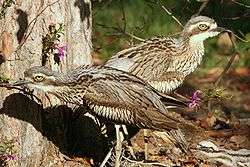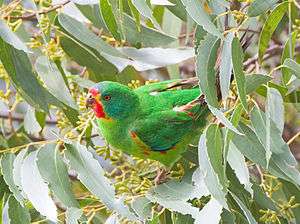Puckapunyal
Puckapunyal (more formally the Puckapunyal Military Area, but also known as the Puckapunyal Camp or Puckapunyal Army Base, and colloquially as "Pucka") is an Australian Army training facility and base 10 km west of Seymour, in central Victoria, south-eastern Australia.[1]
Description
Puckapunyal is a small restricted-access town inhabited mainly by about 280 families of the Australian Defence Force community, with an associated area of about 400 km2 of bushland and former pasture used for field training exercises. It is home to the Australian Army's School Of Armour and the School of Artillery, the School of Transport, and the School of Ordnance, along with the Combined Arms Training and Development Centre, the Joint Logistics Unit, and two transport squadrons.[2] The Royal Australian Armoured Corps Memorial and Army Tank Museum is on the base's grounds,[3] and the facilities are used by the Victorian Australian Army Cadets Brigade.[4] Apart from the military education and training venues, most accommodation consists of single-storey brick houses with backyards. It contains a primary school, shops, a variety of sporting facilities, and a theatre.[5]
History
The area was first used as a mobilisation and training area during World War I.[1] During the early 1920s, an ordnance store and rifle range were built on the site.[1] In 1939, the area was formally established as Puckapunyal Camp: the name was taken from the Aboriginal name for a large hill within the training area, which has been variously translated as "death to the eagle", "the outer barbarians", "the middle hill", "place of exile", and "valley of the winds".[6] The base was used to train the Second Australian Imperial Force, as other Army establishments were at capacity training Militia units.[6] The original site was too small for wartime training, and an additional 5,700 hectares (14,000 acres) were acquired.[1] As well as Australian units, the United States Army's 41st Infantry Division trained at Puckapunyal.[1]
In 1949, the 1st Armoured Regiment was raised at Puckapunyal.[7] The regiment remained based at Puckapunyal until it relocated to Darwin in June 1995.[1]
During the 1950s, Puckapunyal was host to the 3rd National Service Training Brigade (see National Service Act 1951).[1] During the Vietnam War, national servicemen conscripted under the National Service Act 1964 outside of Queensland and New South Wales were sent to Puckapunyal (soldiers from these states trained at Kapooka or Singleton).[8] They were trained by the 2nd Recruit Training Battalion, with up to 4,000 soldiers at Puckapunyal at any given time.
In the 1980s, the Army undertook a land rehabilitation program, as decades of heavy use had caused major land degradation.[3] By 1988, subsequent land acquisitions had increased the training area to 39,290 hectares (97,100 acres).[1]
The National Service barracks were transferred to the Third Training Group in the 1980s to provide recruit and promotion training for General Reserve soldiers and also promotion training for Reserve Officers attending the Reserve Command and Staff College. This continued until the closure of the Training Group in June 2000.
During 1999 and 2000, some 1000 citizens from Kosovo were housed in the Training Group barracks as part of a temporary protection program in support of the NATO activity in the province. They returned to Kosovo once the situation there had stabilized.
Environment

The Puckapunyal Military Area (PMA) experiences cool to cold winters, when most of the average annual rainfall of 596 mm occurs, and dry, warm to hot, summers. The site is characterised by a series of rocky hills and ridges trending north to south, with the highest parts around Mount Puckapunyal (413 m) and Mount Kappe (384 m). The soils are mainly duplex, having low natural fertility and water holding capacity, with smaller areas of deep alluvium. Surface drainage is oriented towards the north and north east, with surface runoff flowing into the Goulburn River. All streams in the PMA are seasonal.[9]
Flora and fauna
The PMA contains box-ironbark forest that forms one of the largest discrete remnants of this threatened ecosystem in Victoria. Some 706 species of vascular, and 170 of non-vascular, plant have been recorded. Two species, clover glycine and trailing hop-bush, are nationally threatened. Records have been made of 44 mammals, 18 reptiles, 12 frogs, 11 fish and over 140 invertebrates.[9]
Birds

The entire PMA, along with two small reserves and an army munitions storage site at nearby Mangalore, has been identified by BirdLife International as a 435 km2 Important Bird Area (IBA) because it supports the largest known population of bush stone-curlews in Victoria. It is also regularly visited by endangered swift parrots, often in large numbers. Diamond firetails are common residents.[10] Other significant birds recorded from the site (out of a total of 207 species) are regent and painted honeyeaters, flame and pink robins, Australasian and black-backed bitterns, powerful and barking owls, and white-throated and spotted nightjars.[9]
In popular culture
Puckapunyal is mentioned in I Was Only Nineteen, the #1 single by Redgum from the 1983 album Caught in the Act. It is also mentioned in episode 84 of Prisoner (aka Prisoner Cell Block H)
References
Notes
- 1 2 3 4 5 6 7 8 Dennis et al. (eds.), The Oxford Companion to Australian Military History, p. 435
- ↑ Dennis et al. (eds.), The Oxford Companion to Australian Military History, pp. 435–6
- 1 2 Dennis et al. (eds.), The Oxford Companion to Australian Military History, p. 436
- ↑ http://www.defence.gov.au/minister/14tpl.cfm?CurrentId=2945
- ↑ "Information about Puckapunyal". Defence Housing Australia. Retrieved 2011-09-24.
- 1 2 "Puckapunyal". Australian War Memorial. Retrieved 12 July 2011.
- ↑ "Unit Information—1st Armoured Regiment, Vietnam". Australian War Memorial. Retrieved 12 July 2011.
- ↑ Ham, Vietnam, p. 172
- 1 2 3 BirdLife International. (2011). Important Bird Areas factsheet: Puckapunyal. Downloaded from http://www.birdlife.org on 2011-09-23.
- ↑ "IBA: Puckapunyal". Birdata. Birds Australia. Retrieved 2011-09-23.
Sources
- Dennis, Peter; Grey, Jeffrey; Morris, Ewan; Prior, Robin (2008). The Oxford Companion to Australian Military History (2nd ed.). South Melbourne, VIC: Oxford University Press. ISBN 978-0-19-551784-2. OCLC 271822831.
- Ham, Paul (2007). Vietnam: the Australian war. Pymble, NSW: HarperCollins. ISBN 978-0-7322-8237-0. OCLC 225613062.
External links
Coordinates: 37°00′S 145°02′E / 37.000°S 145.033°E